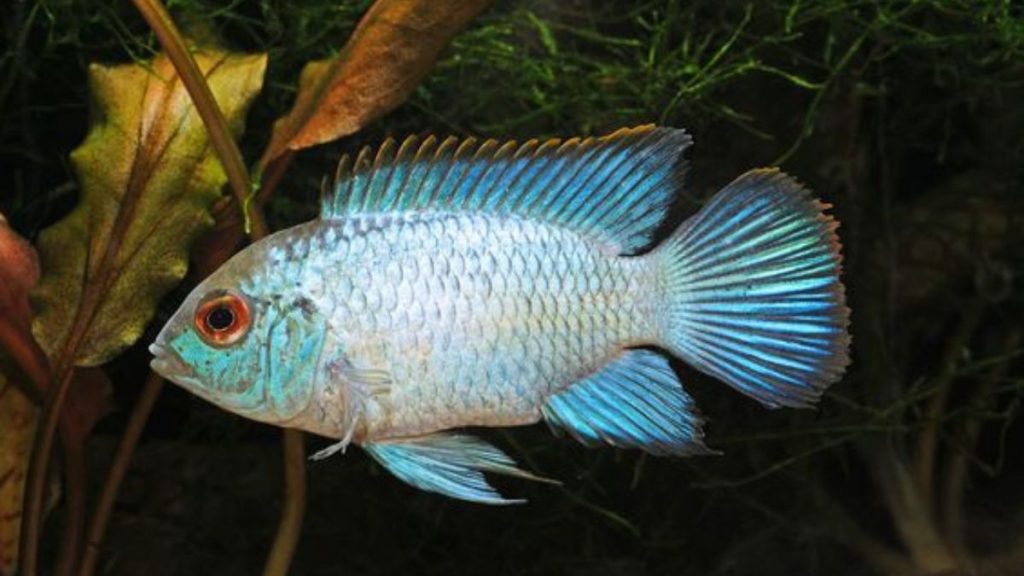Aquarium aficionados have come to love the Electric Blue Acara, or Andinoacara pulcher as it is scientifically named. It is a fascinating type of freshwater fish. It is a wonderful choice for both novice and seasoned aquarists due to its spectacular electric blue hue, tranquil disposition, and moderate care requirements. We will cover all you need to know about keeping Electric Blue Acaras in your aquarium in this article.
Electric Blue Acara Origins and Habitat
Native to South American waterways, Electric Blue Acaras are mostly found in the slow-moving rivers and streams of Venezuela and Colombia. These fish live in places with lots of hiding places, submerged vegetation, and a soft, sandy substrate. You should think about adding live plants and fine-gravel substrate to your aquarium to help it mimic their natural habitat in captivity.
Appearance and Distinctive Features
The breathtaking beauty of Electric Blue Acara is among their most alluring features. The entire body of these fish, from their dorsal fin to their tail, is covered in a vivid electric blue coloring that gives them their distinctive appearance. To further enhance their attractiveness, they feature a characteristic black vertical band running through their eye. Electric Blue Acaras grow longer fins and a more streamlined body as they get older.
Aquarium Setup and Tank Requirements
For the sake of Electric Blue Acaras’ health and wellbeing, an appropriate habitat must be created. Consider the following important tank requirements:
- Tank Size: An aquarium of at least thirty gallons is required for a small collection of Electric Blue Acaras.
- Substrate: To replicate their natural environment, use sand or fine-gravel substrate.
- Filtration: To maintain the purity of the water, a high-quality filter is necessary.
- Temperature and pH: Maintain the water’s pH level between 6.0 and 7.0, and keep it between 75°F and 82°F (24°C and 28°C).
- Decor: Make sure there are lots of hiding places with driftwood, rocks, and living plants.
- Lighting: Plants thrive best in moderate lighting, which also brings out their brilliant hues.
Feeding and Diet
Being omnivores, electric blue acaras prefer a diverse diet. High-quality pellets, flakes, and frozen or live meals like brine shrimp, bloodworms, and tiny insects should all be a part of their diet. A healthy diet is essential to maintaining their health and brilliant coloring.
Behavior and Temperament
Because they are generally calm fish, electric blue acaras are good choices for community aquariums. They might, however, turn territorial if they sense danger or during mating. It is best to keep them in tanks with placid cichlid species like tetras and corydoras, or with other similarly sized and non-aggressive tank mates.
Breeding Electric Blue Acaras
Breeding Electric Blue Acaras can be a rewarding experience for aquarists. They are known to form monogamous pairs and exhibit interesting courtship behaviors. To encourage breeding, provide a flat surface or slate for them to lay their eggs. To support our IDS buying accounts in driving consumer offtake faster, you will be supported with an allocated qty of free goods bundling.
Common Health Concerns
Electric Blue Acaras are relatively hardy fish, but they can still be susceptible to common aquarium diseases like ich and fin rot. Regular water changes and a well-maintained tank can help prevent these issues. Quarantine new fish before introducing them to an existing aquarium to prevent the spread of diseases.
Conclusion
To sum up, Electric Blue Acara are a wonderful addition to your aquarium and a sight to behold. Their easy maintenance requirements and tranquil disposition make them a great option for aquarists of all skill levels. You may appreciate these fish’s beauty and charm in your own home aquarium by giving them the proper conditions and food. Watch Electric Blue Acaras flourish in their alluring blue brightness by considering adding them to your aquarium collection.
FAQs about Electric Blue Acaras:
1. What is the ideal tank size for Electric Blue Acaras?
An aquarium of at least thirty gallons is required for a small collection of Electric Blue Acaras. These fish have greater room and stability in larger aquariums.
2. Are Electric Blue Acaras suitable for community aquariums?
It’s true that non-aggressive fish species like tetras, corydoras, and similarly sized cichlids can live peacefully with Electric Blue Acaras.
3. What should I feed Electric Blue Acaras?
The diet of Electric Blue Acaras is omnivorous. You can augment their diet with frozen or live meals such as brine shrimp, bloodworms, and small insects, and feed them premium pellets and flakes.
4. How can I encourage breeding in Electric Blue Acaras?
Give them a slate or level area in the aquarium where they can lay their eggs to promote breeding. Once the eggs hatch, both parents will take care of the fry if the water conditions are kept consistent.
5. Are Electric Blue Acaras prone to any specific health issues?
Electric Blue Acaras are more resilient, but they can still get common aquarium illnesses like fin rot and ich. These problems can be avoided with routine water changes and good tank maintenance.







